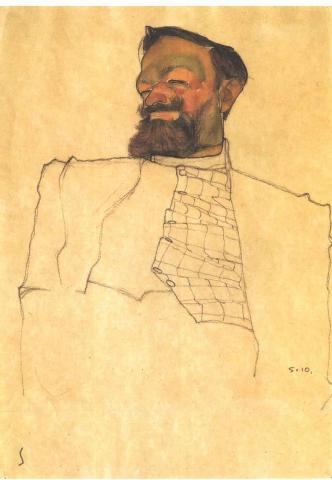Carl Reininghaus was the oldest son of Julius Reininghaus and Emilie, née Mauthner Markhof. After his father's early death, his uncle Johann Peter Reininghaus bought his shares in Grazer Brauerei. The proceeds, which included a paint factory and slurry works in Gösting, gave Carl financial independence. He collected and supported art. According to the Handbuch der Kunstpflege in Österreich he possessed one of the most important collections in Styria at the turn of the century, including paintings by Hans Makart, Hans Thoma and Wilhelm von Kaulbach, as well as "a few older Italians". For personal reasons (divorce from his first wife Zoë, née von Karajan; extramarital relationship with Marie Schneider from Klosterneuburg) he moved in 1904 from Graz to Vienna. At the same time he focused his collecting activities on Modernist works and was in close contact with Gustav Klimt, Egon Schiele and other Secession artists. He acquired several works by Ferdinand Hodler. In 1907 he purchased the Beethoven frieze painted by Klimt for the 14th exhibition of the Vienna Secession, which he sold to August Lederer in 1915. He wrote in his will that he wished his collection to remain intact after his death, but drawn-out estate proceedings, outstanding debts and the dramatic drop in prices as a result of the world economic crisis made it necessary to sell individual works. Some of the items were ultimately distributed among the heirs and others sold through art dealers and auction houses in Vienna and Switzerland. Two works are now in the Kunsthistorisches Museum Wien: an antique gravestone offered but not sold by Glückselig in 1933, purchased by the Collection of Greek and Roman Antiquities in 1940, and the painting Madonna and Child attributed to Sebastiano Mainardi, allocated to it 1969. This fifteenth-century picture was one of the main works in the collection and was sold in 1940 for 100,000 Reichsmarks for the "Sonderauftrag Linz" (Linz museum project). In 1945 it was stored in the Central Collecting Point in Munich, and in 1958 the West German Treuhandverwaltung für Kulturgut (Trusteeship for the Administration of Cultural Assets) handed it to the Republic of Austria. Shortly afterwards, the seller demanded that the painting be returned. However, the Finanzprokuratur (Office of the Financial Procurator) dealing with the matter in 1969 determined that the sale had not been connected with expropriation by the Nazi regime and therefore presented no grounds for restitution. The Federal Ministry of Education subsequently assigned the painting to the Kunsthistorisches Museum, where it had been since 1958. In the course of systematic provenance research the Art Restitution Advisory Board also decided against restitution in 2016.
Carl (von) Reininghaus

Beschluss des Kunstrückgabebeirats, Carl Reininghaus, 1.4.2016, URL: www.provenienzforschung.gv.at/beiratsbeschluesse/Reininghaus_Carl_2016-04-01.pdf (3.12.2020).
Auktionshaus für Altertümer Glückselig (Hg.), Gemälde und Antiquitäten aus dem Nachlasse Carl (v.) Reininghaus. Wertvolle Musikinstrumente und Künstlerdokumente aus dem Nachlasse Ernst Löwenfeld. Mobiliar und Kunstgegenstände aus Wiener Privatbesitz, Wien 1933, [Auktion: 29.–30.5.1933], URL: doi.org/10.11588/diglit.10785.
Handbuch der Kunstpflege in Österreich. Herausgegeben vom k. k. Ministerium für Cultus und Unterricht, redigiert von Wilhelm Freiherrn von Weckbecker, 3. Aufl., Wien 1902.
Susanne Hehenberger, Madonna mit Kind und zwei Engeln. Ein Renaissancegemälde aus der Sammlung Carl Reininghaus, in: Eva Blimlinger/Heinz Schödl (Hg.), … (k)ein Ende in Sicht. 20 Jahre Kunstrückgabegesetz in Österreich (= Schriftenreihe der Kommission für Provenienzforschung 8), Wien-Köln-Weimar 2018, 257–273, URL: doi.org/10.7767/9783205201274.257.
Karl Reininghaus. Ein Gedenkwort von Karl [Carl] Moll, in: Neue Freie Presse, 17. November 1929, 37–38, URL: anno.onb.ac.at/cgi-content/anno?aid=nfp&datum=19291117&seite=37 (3.12.2020).
Ulrike Tropper, Die Sammlung Carl von Reininghaus. Ein Beispiel privater Kunstförderung um 1900, in: Gotthart Wunberg, Dieter A. Binder (Hg.), Pluralität. Eine interdisziplinäre Annäherung. Festschrift für Moritz Csáky, Wien 1996, 258–273.
Michael Wladika, Dossier Provenienzforschung bm:ukk – LMP, LM Inv. Nr. 465, 30. Juni 2010, URL: www.bmkoes.gv.at/dam/jcr:afd3e3cc-e3a0-49ee-8e79-85f8a01e73ba/dossier_schiele_sitzendermaennerakt.pdf (3.12.2020).
BArch Berlin, NS 6, S. 194/223, III. Gemälde-Sammeltransport von München-Führerbau nach Alt-Aussee (Salzberg), 13.8.1944.
BArch Koblenz, B 323/332, Kunsthändler-Aussagen K-Z, Georg Reininghaus an Erika Zeise, CCP München, 9.6.1951.
BArch Koblenz, B 323/576, Sonderauftrag Linz. Verzeichnis der der Treuhandverwaltung von Kulturgut München bekanntgewordenen Restitutionen von 1945 bis 1962. Österreich A-Z, Reininghaus.
BDA-Archiv, Restitutionsmaterialien, PM Friederike Reininghaus.
BDA-Archiv, Restitutionsmaterialien, K. 10, Mappe 5.
GNM Nürnberg, DKA, NL Posse, Hans, I, B-1, Tagebuch Hans Posse 1936–1942, Eintrag Mittwoch, 16.10.1940.
KHM, Archiv der Gemäldegalerie, 44/GG/1931, 27/GG/1965.
KHM-Archiv, 78/AK/1935, 194/KL/1938, 187/KL/1939, 138/KL/1940.
OeStA/AdR, E-uReang, FLD, Zl. 22896, Friederike Reininghaus.
OeStA/AdR, UWK, BMU, Kunstangelegenheiten, Sammelmappe 331.
WStLA, Bezirksgericht Hietzing, Abt. 2 A, Verlassenschaft Carl Reininghaus.
WStLA, Historische Wiener Meldeunterlagen, Meldeauskunft Carl Reininghaus.
WStLA, Historische Wiener Meldeunterlagen, Meldeauskunft Friedrike Reininghaus.
